Related Research Articles

The numbat, also known as the noombat or walpurti, is an insectivorous marsupial. It is diurnal and its diet consists almost exclusively of termites.

Habitat conservation is a management practice that seeks to conserve, protect and restore habitats and prevent species extinction, fragmentation or reduction in range. It is a priority of many groups that cannot be easily characterized in terms of any one ideology.

The bridled nail-tail wallaby, also known as the bridled nail-tailed wallaby, bridled nailtail wallaby, bridled wallaby, merrin, and flashjack, is a vulnerable species of macropod. It is a small wallaby found in three isolated areas in Queensland, Australia, and whose population is declining. In early 2019 the total population of the species was estimated to be fewer than 500 mature individuals in the wild and 2285 in captivity.
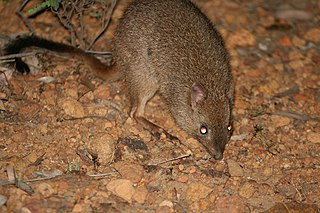
The woylie or brush-tailed bettong is a small, critically endangered mammal native to forests and shrubland of Australia. A member of the rat-kangaroo family (Potoroidae), it moves by hopping and is active at night, digging for fungi to eat. It is also a marsupial and carries its young in a pouch. Once widespread, the woylie mostly died out from habitat loss and introduced predators such as foxes. It is currently restricted to two small areas in Western Australia. There were two subspecies: B. p. ogilbyi in the west, and the now-extinct B. p. penicillata in the southeast.

The Easter Bilby is an Australian alternative to the Easter Bunny and chocolate bunnies. Bilbies are native Australian marsupials that are endangered. To raise money and increase awareness of conservation efforts, bilby-shaped chocolates and related merchandise are sold within many stores throughout Australia as an alternative to Easter bunnies.

Barrington Tops is part of the Great Dividing Range in New South Wales, Australia, between Gloucester and Scone.

The western quoll is Western Australia's largest endemic mammalian carnivore. One of the many marsupial mammals native to Australia, it is also known as the chuditch. The species is currently classed as near-threatened.
Wongalara Sanctuary is a nature reserve in the Top End of the Northern Territory of Australia.
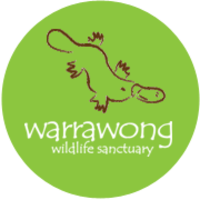
Warrawong Wildlife Sanctuary, formerly Warrawong Sanctuary, is a wildlife reserve in the Australian state of South Australia located in the suburb of Mylor about 17 kilometres (11 mi) south-east of the centre of the state capital of Adelaide.

The Western barred bandicoot, also known as the Shark Bay bandicoot or the Marl, is a small species of bandicoot; now extinct across most of its former range, the western barred bandicoot only survives on offshore islands and in fenced sanctuaries on the mainland.

The greater stick-nest rat, also known as the housebuilding rat and wopilkara, is a species of rodent in the family Muridae. They are about the size of a small rabbit and construct large nests of interwoven sticks. Once widespread across southern Australia, the population was reduced after European colonisation to a remnant outpost on South Australia's Franklin Islands. The species has since been reintroduced to a series of protected and monitored areas, with varying levels of success.
Mount Rothwell Biodiversity Interpretation Centre is the largest feral-predator-free ecosystem in Victoria, Australia. It is located just north of the You Yangs, near the town of Little River.

The Australian Wildlife Conservancy (AWC) is an independent Australian nonprofit organisation, working to conserve threatened wildlife and ecosystems in Australia. AWC is the largest private owner and manager of land for conservation in Australia, currently managing 31 sanctuaries and partnership sites for wildlife conservation that cover over 6.5 million hectares of land across Australia. It partners with governmental agencies, Indigenous groups, and private landholders to manage landscapes for effective conservation. Most funding comes from private support in the form of tax-deductible donations from the public, as well as some government grants for particular purposes, such as from the Australian government's National Reserve System Program.
Buckaringa Sanctuary is a 20 km2 nature reserve in the southern Flinders Ranges of South Australia. It is 30 km north of the town of Quorn. It is owned and managed by the Australian Wildlife Conservancy (AWC).
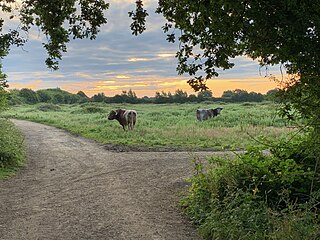
Rewilding is a form of ecological restoration aimed at increasing biodiversity and restoring natural processes. It differs from other forms of ecological restoration in that rewilding aspires to reduce human influence on ecosystems. It is also distinct from other forms of restoration in that, while it places emphasis on recovering geographically specific sets of ecological interactions and functions that would have maintained ecosystems prior to human influence, rewilding is open to novel or emerging ecosystems which encompass new species and new interactions.

Mulligans Flat Woodland Sanctuary is a protected area situated in the Gungahlin district in north Canberra in the Australian Capital Territory. It has several trails for walking, running and cycling. The sanctuary functions as a fieldwork site for researchers studying native ecology.
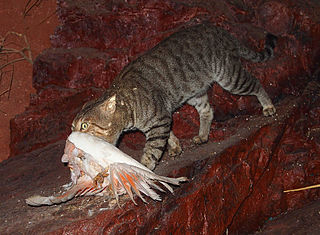
Feral cats are an invasive species in Australia. Because they are not native to Australia and were only introduced by European colonists as pets in the early 1800s, native Australian animals did not co-evolve with them. As of 2016, some 3.8 million domestic cats and up to 6.3 million feral cats continue to live in Australia.
Rewilding Europe is a non-profit organization based in Nijmegen, the Netherlands, dedicated to creating rewilded landscapes throughout Europe. The group's efforts have contributed to increasing the stock of previously endangered species such as the European bison and the Iberian lynx.
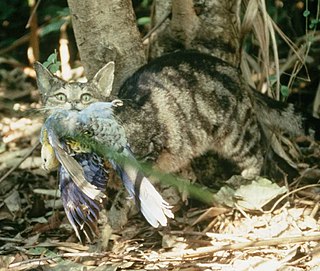
Cat predation on wildlife is the result of the natural instincts and behavior of both feral and owned house cats to hunt small prey, including wildlife. Some people view this as a desirable trait, such as in the case of barn cats and other cats kept for the intended purpose of pest control in rural settings; but scientific evidence does not support the popular use of cats to control urban rat populations, and ecologists oppose their use for this purpose because of the disproportionate harm they do to native wildlife. Recognized as both invasive species and predators, cats have been shown to cause significant ecological harm across various ecosystems.
References
- ↑ "John Wamsley - Prime Minister's Environmentalist of the Year 2003". Minister for the Environment and Heritage Media Releases. Department of the Environment & Water Resources. 14 July 2004. Archived from the original on 29 September 2007. Retrieved 29 August 2007.
- 1 2 Radford, Leigh. "John Wamsley". ABC Rural . Australian Broadcasting Corporation. Retrieved 8 October 2015.
- ↑ "The Deficiency of Finite Groups".
- ↑ Adams, Prue (27 March 2005). "Wamsley walks away from Earth Sanctuaries". Landline . Australian Broadcasting Corporation. Retrieved 28 December 2018.
- 1 2 3 4 5 6 Paull, John (2021) "Ecosystem Restoration: The Bold Experiment for Rewilding Australia", International Sustainable Development Research Society (ISDRS) Newsletter, Q4(1):5.1-5.4.
- ↑ Emmett, Patrick (25 March 2005). "Cat hat man runs out of lives?". Stateline . Archived from the original on 3 March 2016.
- ↑ Kizilos, Katherine (28 February 2007). "The ark at Little River". The Age . Retrieved 26 June 2024.
- ↑ "A Win for Australian Conservation: Australian Wildlife Conservancy to Acquire Sanctuaries from Earth Sanctuaries Ltd". Australian Wildlife Conservancy . 2002. Archived from the original on 24 August 2014. Retrieved 26 June 2024.
- ↑ Wamsley, John; Davey, Stephen L. (29 October 2020). A Vanishing Kind: A Memoir of Dr John Wamsley in Conversations. Balboa Press. ISBN 978-1-5043-2295-9.